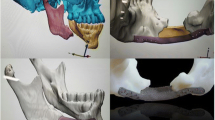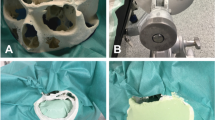Abstract
Purpose
Presentation of a new cranioplasty technique employing a combination of two technologies: rapid prototyping and surgical navigation. This technique allows the reconstruction of the skull cap after the resection of a bone tumor in a single surgical time.
Methods
The neurosurgeon plans the craniotomy previously on the EximiusMed software, compatible with the Eximius Surgical Navigator, both from the company Artis Tecnologia (Brazil). The navigator imports the planning and guides the surgeon during the craniotomy. The simulation of the bone fault allows the virtual reconstruction of the skull cap and the production of a personalized modelling mold using the Magics—Materialise (Belgium)—software. The mold and a replica of the bone fault are made by rapid prototyping by the company Artis Tecnologia (Brazil) and shipped under sterile conditions to the surgical center. The PMMA prosthesis is produced during the surgical act with the help of a hand press.
Results
The total time necessary for the planning and production of the modelling mold is four days. The precision of the mold is submillimetric and accurately reproduces the virtual reconstruction of the prosthesis. The production of the prosthesis during surgery takes until twenty minutes depending on the type of PMMA used. The modelling mold avoids contraction and dissipates the heat generated by the material’s exothermic reaction in the polymerization phase. The craniectomy is performed with precision over the drawing made with the help of the Eximius Surgical Navigator, according to the planned measurements. The replica of the bone fault serves to evaluate the adaptation of the prosthesis as a support for the perforations and the placement of screws and fixation plates, as per the surgeon’s discretion.
Conclusions
This technique allows the adequate oncologic treatment associated with a satisfactory aesthetic result, with precision, in a single surgical time, reducing time and costs.









Similar content being viewed by others
References
Krause-Titz UR, Warneke N, Freitag-Wolf S, Barth H, Mehdorn HM (2015) Factors influencing the outcome (GOS) in reconstructive cranioplasty. Neurosurg Rev 39(1):133–139
Jaberi J, Gambrell K, Tiwana P, Maddenn C, Finn R (2013) Long-term clinical outcome analysis of poly-methyl-methacrylate craniplasty for large skull defects. J Oral Maxillofac Surg 71:e81–e88
Wildmann G, Stoffener R, Bale R (2009) Errors and error management in image-guided cranimaxillofacial surgery. Oral Maxillofac Radiol 107(5):701–715
Vidal FP, Bello F, Brodlie KW, Gould DA, John N, Phillips R, Avis NJ (2006) Principles and applications of computer graphics in medicine. Comput Graph Forum 25(1):113–137. doi:10.1111/j.1467-8659.2006.00822.x
Chauhan H, Rao SG, Chandramurli BA, Sampath S (2011) Neuro-navigation: an adjunct in craniofacial surgeries: our experience. J Maxillofac Oral Surg 10(4):296–300
Bruneau M, Kamouni R, Schoovaerts F, Pouleau HB, De Witte O (2015) Simultaneous image-guided skull bone tumor resection and reconstruction with a preconstructed prosthesis based on an OsiriX virtual resection. Neurosurgery 11(4):484–490
Ridwan-Pramana A, Marcián P, Borák L, Narra N, Forouzanfar T, Wolff J (2016) Structural and mechanical implications of PMMA implant shape and interface geometry in cranioplasty—a finite element study. J Craniomaxillofac Surg 44(1):34–44. doi:10.1016/j.jcms.2015.10.014
Kumar NG, Rangarajan H, Shourie P (2015) Cranioplasty of hemispherical defects using high impact methylmethacrylic plate. J Craniofac Surg 26(6):1882–1886. doi:10.1097/SCS.0000000000002006
Westendorff C, Hoffmann J, Troitzsch D, Dammann F, Reinert S (2004) Ossifying fibroma of the skull: interactive image-guided minimally invasive localization and resection. J Craniofac Surg. 15(5):854–858
Acknowledgments
We thank the medical team that executed the case which illustrates the new technique: Dr. Ítalo Caprano Suriano, Dr. Bruno Fernandes de Oliveira Santos and Dr. Samuel Salu (Federal University of Sao Paulo-UNIFESP).
Author information
Authors and Affiliations
Corresponding author
Ethics declarations
Conflict of interest
The authors whose names are listed immediately below certify that they have no affiliations with or involvement in any organization or entity with any financial interest (such as honoraria; educational grants; participation in speakers’ bureaus; membership, employment, consultancies, stock ownership, or other equity interest; and expert testimony or patent-licensing arrangements) or non-financial interest (such as personal or professional relationships, affiliations, knowledge or beliefs) in the subject matter or materials discussed in this manuscript. Author names: Bruno Fernandes de Oliveira Santos. The authors whose names are listed immediately below report the following details of affiliation or involvement in an organization or entity with a financial or non-financial interest in the subject matter or materials discussed in this manuscript. Author names: Marcos Vinicius Marques Anchieta, Frederico Assis de Salles, Bruno Cassaro Dal’Ava and Marcelo Marques Quaresma. The authors above are developers of the technics described in the manuscript and shareholders of the company Artis Technologia, who made a donation of both the mold in rapid prototyping, as Eximius Surgical Navigator to the procedure. The surgery which illustrates the case was conducted in a university hospital of Medicine School of the Federal University of Sao Paulo-UNIFESP, which is public and free. There was no cost to the patient.
Rights and permissions
About this article
Cite this article
Anchieta, M.V.M., Salles, F.A., Cassaro, B.D. et al. Skull reconstruction after resection of bone tumors in a single surgical time by the association of the techniques of rapid prototyping and surgical navigation. Int J CARS 11, 1919–1925 (2016). https://doi.org/10.1007/s11548-016-1415-2
Received:
Accepted:
Published:
Issue Date:
DOI: https://doi.org/10.1007/s11548-016-1415-2




